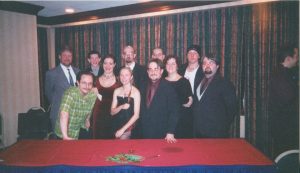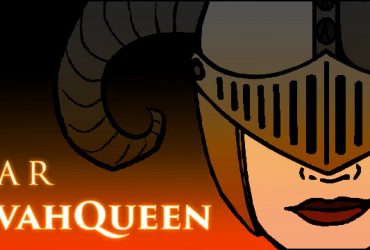I frequently write about how to tell good stories with the other people at your gaming table, I do that because my preferred style of gaming involves character and story development, which I learned during my years of LARPing and the subsequent WW table top years. I spent much of the last week thinking about how my gaming style was so heavily influenced by the Storyteller system in the wake of the news that Stewart Wieck, co-founder of White Wolf, passed unexpectedly on June 22, 2017. I did not have the pleasure of meeting Stewart in person or knowing him beyond reputation, but I can trace my love of table top gaming back down a wide and long highway that passes through White Wolf territory.
Unlike Dungeons & Dragons and Pathfinder, which grew out of dice mechanics and war gaming, the Storytelling System (in this case I mean old World of Darkness, I have not played the newer editions enough to speak to them) bases experience point accrual on the portrayal of the character through role playing and encourages exploration of the character’s flaws and merits, not solely through the destruction of other creatures.
Table Top vs LARP role-playing
Chances are if you’re reading this you have played a table top role-playing game at least once, but you might have never had the opportunity to game LARP (Live Action Role Play) style. LARP is a lot like table top – you have a character sheet created based on rules, there are players and Storytellers (GMs), books and books of rules options, and challenges are resolved through various methods, most often “Rock, Paper, Scissors” but I have used other methods as well. The big change is where and how you play out the action.
I have physically LARPed at private residences, game stores, University campuses, the tops of various hotels in manycities, a beautiful Masonic Temple, old theaters and art studios, in a Goth club and the back alley of the club, a campground, as well as countless virtual scenes that take place with people all around the world via email. As such, each location called for different gear, when you LARP you fully portray your PC through body language, costuming, and safe props (no weapons, not even fake ones). Depending on your character, a player may wear a suit, leather coat, formal gown, cut-off jeans, pajamas, the sky’s the limit (although being mindful of your surroundings and try not to scare/offend the locals).
Unlike table top gaming, LARPing is more akin to improvisational theater (and I have listed it as such on my resume, yeah really), players walk around the site, interacting with one another, frequently just talking. Depending on the core game – Vampire, Changeling, Werewolf, Hunters, or Mage – the conversation takes on a different lexicon, but generally players are plotting, planning, gossiping, and listening very carefully, possibly jockeying for power or trying to figure out a war plan for taking down Pentex (they’re of the Wyrm, of course we’re going to stop them).
The Inner Struggle
As you can see, there’s a lot of time when players are not engaging with the Storytellers, I’ve played entire weekend events and only talked with the Storytellers at check in and in the buffet line. The heavy lifting of storytelling is done on the player level and frequently the conflict is player on player. There is always room for big story arcs lead by the ST, but a player doesn’t have to engage and the more PCs involved the more difficult it can be to adjudicate combats (I’ve been in scenes, combat and otherwise with upwards of 20 or more players plus NPCs – usually portrayed by STs or volunteers). This improv setting allows for in game interactions on such a level that might be awkward at a table. At LARP you can have private conversations in private, at a table, there’s always witnesses, even if the PCs aren’t present, it’s hard to separate what a PC hears and what a player hears if things aren’t explicitly stated.
Sitting down with another single player or small group and role playing characters as they struggle with who and what they are is liberating and introspective for me. Part of the deeper story for Vampire: the Masquerade was the internal struggle and personal horror of being changed from a human into a blood thirsty monster. This kind of story focus moves the players from “killing the thing” to “subduing the angst or giving into it”. I’ve played characters along the spectrum – high humanity, low humanity, and all the points in between. My goal every game was to never need my character sheet, and frequently I succeeded. I have never played a table top game session that I walked away from feeling accomplished without having to pick up dice at least once. Yet LARPing allows the players to use their powers of persuasion, augmented by their character sheets if they like, to change the course of the story.
The danger of LARPing is recognizing that the emotions that you’re feeling as a player aren’t your own, but those of your character, the immersion of the system can allow you to form long and lasting friendships or deep animosity, depending on how everyone manages their own emotional wellbeing. My personal LARP style is in keeping with the Nordic LARP philosophy as I do not believe there is a way to “win or lose” at LARP, it is the journey of the character(s), however there are other thoughts on that front that we won’t be exploring right now.
Immersion style at the table
Our primary table top crew is made up exclusively of friends that we also have LARPed with at times, so we’re pretty old hat when it comes to interacting with one another. When I sit down at a table with new people, sometimes it’s intimidating to go deep in a character that is a pre-gen that I know next to nothing about, that’s when the old improv comes into play. I find something I can hang my hat on – maybe an especially high or low stat or skill, or an item my character’s carrying. I do not recall ever sitting down and having a fully formed character concept to my recollection, largely because of my game playing style, my background information is vague hints at best and even I don’t know my PCs until I sit down at a table and chat with them in play.
Love your designers
In my day life away from the gaming community, I am a hospice nurse, I deal with life and death every day. The gaming community as we know it was built by an aging group of individuals. We will be celebrating the 50th Gen Con in just two months. Whether in person or in the virtual world, please consider reaching out to the writers, designers, artists, cartographers, editors, layout designers, and all the other talented and amazing individuals who help create your personal favorite gaming materials and thank them, personally. We make things because it is our nature, we make games because it is our passion. Buying our products feeds our bellies (and our families’), thanking us personally feeds our souls.
To those of you who read my blog, thank you for your support, it is my pleasure to be part of your gaming experience.
In the photo below, I am reading a poem that was gifted to me as the Toreador Primogen of Cincinnati, I have several pieces of original artwork from my time LARPing. As well, I am fortunate to count some of the people shown among my friends still. Gaming will always be a part of my life, for better or worse. Thank you to all who make this community fun to be a part of, especially my friends in Know Direction Network, you are the best.









